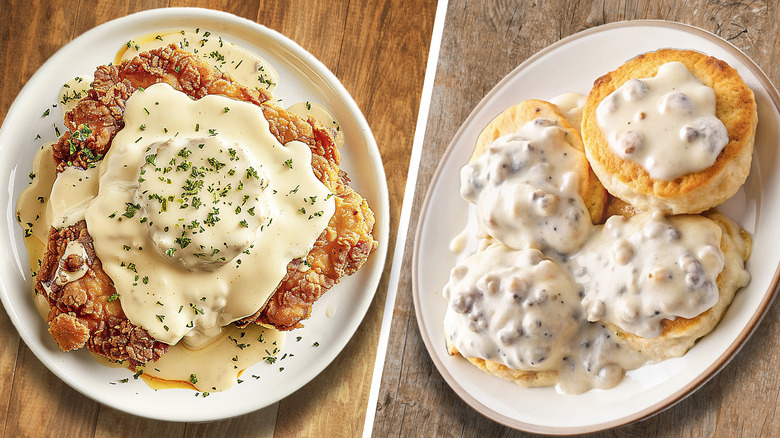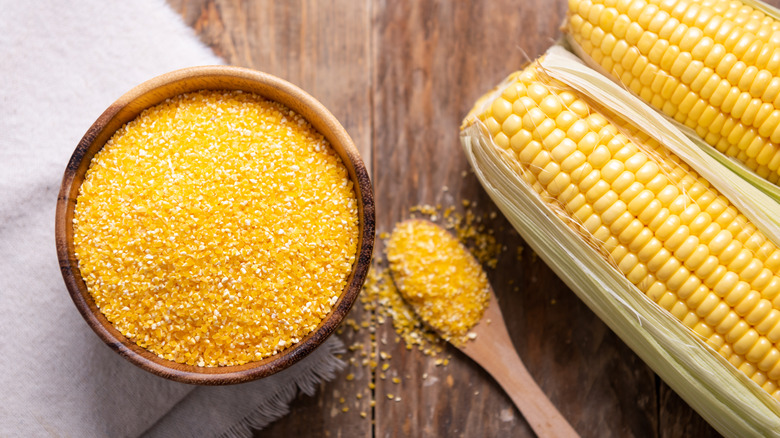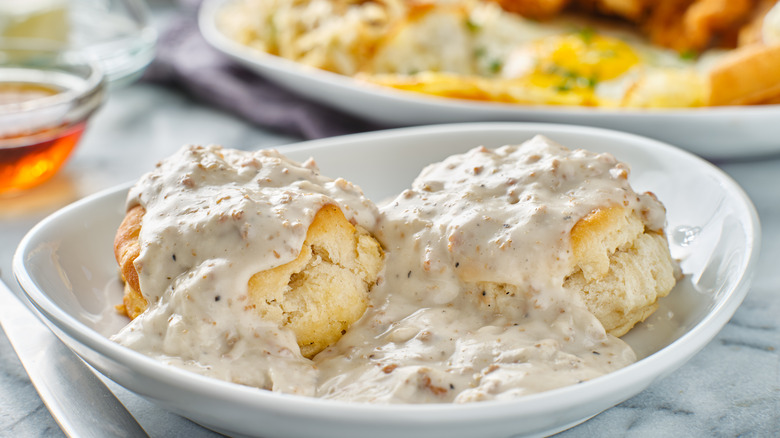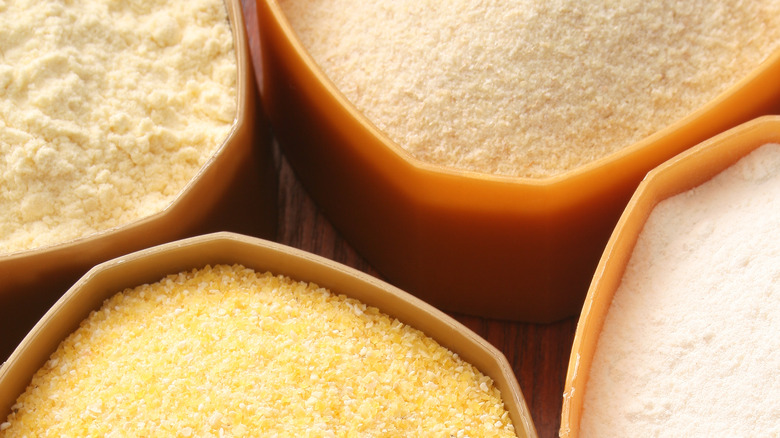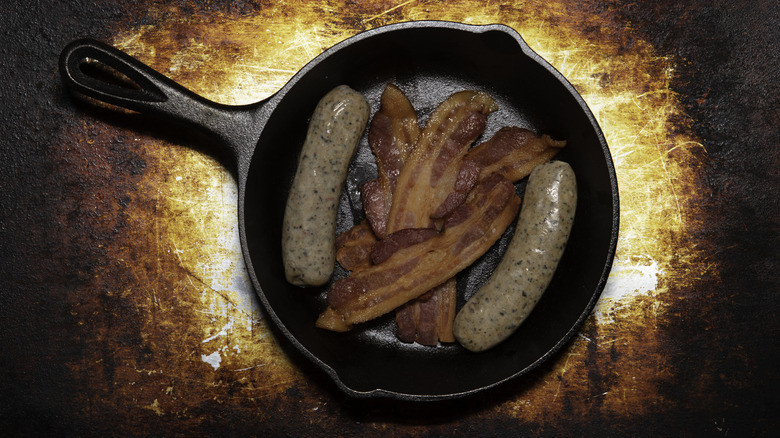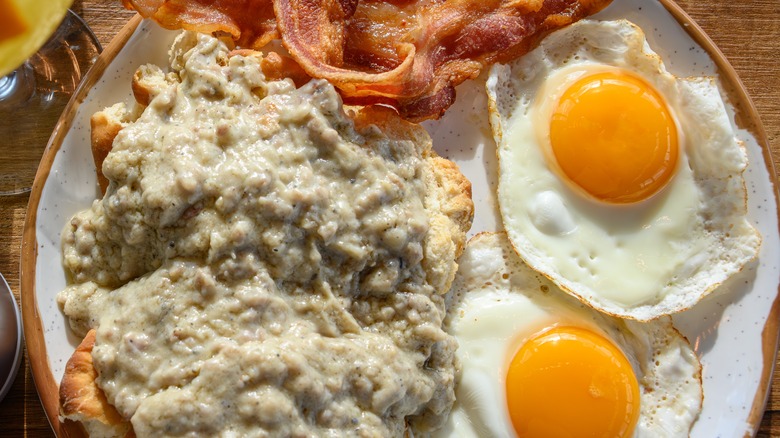Cornmeal Vs Sawmill Gravy: What's The Difference?
If there's one thing the Southern U.S. does well, it's gravy. When resources were sparse — as they were for many American settlers — knowing how to squeeze every drop of nutrition from your food was a crucial skill. Rendered fat leftover from pan-frying sausage or bacon presented an inexpensive source of nutrients that these settlers couldn't afford to pass up, and they quickly found ways to include it in their daily diets.
This waste-not mentality fueled the invention of a wide variety of thick, creamy gravies that many present-day Americans view as cultural staples. In particular, cornmeal gravy and sawmill gravy are traditional Southern staples that began as delicious and practical recipes for using pan drippings to round out meals with hearty flavor. Cornmeal gravy isn't as well-known as is it's sausage-rich cousin, and both recipes have little in common in the way of ingredients and uses. However, their shared history means we likely wouldn't have one without the other.
What is cornmeal gravy?
As the name suggests, cornmeal is the main thickener in cornmeal gravy. Corn has been cultivated in North America for about 9,000 years and was a staple crop for First Nations communities throughout the present-day United States. In fact, Indigenous peoples along the Mississippi Delta made a version of cornmeal gravy called selu'si asusdi.
Later, Southern settlers of European descent built on this idea to create cornmeal gravy. It's unclear whether they learned the recipe from their indigenous neighbors or came up with it independently. Either way, both recipes were used to add flavor and calories to meals when resources were sparse.
Traditional cornmeal gravy recipes start with pan drippings from ham or bacon. Cornmeal is stirred into the warm drippings to absorb the fat and flavor, then finished off with milk or buttermilk to make the mixture creamier. However, cornmeal is harder than flour, so it will take on a porridge-like consistency instead of being smooth and pourable.
What is sawmill gravy?
This popular version of sausage gravy has a rich history. It's thought to be a descendant of cornmeal gravy, as the original recipe called for a mixture of cornmeal and flour. Later recipes nixed the cornmeal for a flour-only base, and this is the version that we know and love today.
Sawmill gravy gets its original name from where it was traditionally served. In the late 19th century, logging was one of the largest and most lucrative industries in the Appalachian region. Loggers worked hard all day cutting, processing, and floating logs downriver, and they required plenty of hearty food to keep them strong enough to work. Flour, cornmeal, milk, sausage, and hard biscuits were relatively inexpensive, easy to get, and easy to store. Biscuits and gravy quickly became a staple in the loggers' diets, and the hearty gravy became associated with sawmills. Some also say that the moniker came from the cornmeal in the original recipe, as it gave the gravy a gritty texture similar to sawdust, which may be why we no longer typically use cornmeal in this recipe.
Sawmill gravy is smoother and thinner
The main difference between cornmeal gravy and sawmill gravy is the base ingredient. Cornmeal gravy, of course, uses cornmeal, while modern versions of sawmill gravy only use wheat flour. That means cornmeal gravy is naturally thicker and denser with a slightly gritty texture, while sawmill gravy is smoother and a little thinner.
Some people prefer cornmeal gravy because it's reminiscent of grits or porridge, and the thicker texture of both foods is more filling and satisfying than sawmill gravy. However, sawmill gravy is the more popular of the two because it's pleasing to more palates. When combined with warm sausage fat and milk, flour naturally becomes creamy and thick. That rich, creamy texture sinks easily into biscuits or toast for a meal that satisfied even the lumberjacks of America's past. Conversely, though cornmeal does soften a little during the cooking process, it's coarser than most wheat flours, so it doesn't absorb moisture as easily and will always retain a grainy texture.
Cornmeal gravy typically utilizes ham and bacon
Though you could certainly use rendered fat from ham, bacon, or sausage for either of these gravies, cornmeal gravy is typically blended with ham and bacon. Meanwhile, sausage fat is reserved for the flour base of sawmill gravy. Ham and bacon drippings impart a salty, smoky flavor distinctive of cured pork products, and the cornmeal develops a slightly nutty flavor as it toasts in the fat for a savory, earthy result.
For sawmill gravy, the hearty flavor of sausage drippings is often undercut by herbs like sage and fennel seed, whose flavors are easily soaked up by the flour. As a classic seasoning in sawmill gravy, black pepper also helps elevate the flavor of the sausage while blending the other flavors together. Rendered sausage is also usually folded into sawmill gravy for extra nutrition and flavor. Which of these profiles is best depends largely on personal preference. Both gravies have a deep, hearty flavor from pork drippings, but cornmeal gravy is smoky and salty, whereas sawmill gravy's flavor is more complex.
Cornmeal gravy is great for dinner
Though both of these gravies are tasty enough to enjoy any time of day, you're much more likely to see sawmill gravy over biscuits for breakfast. Cornmeal gravy, on the other hand, is usually served for dinner over main dishes that you might see in today's diners, such as chicken-fried steak or fried pork chops. It's not entirely clear how sawmill gravy became a Southern and Appalachian breakfast staple, but the American tendency to enjoy sausage for breakfast may have something to do with it.
Soft, fluffy Southern biscuits — a far cry from their hard, dry cousins of yesteryear — also often make an appearance at breakfast with butter and honey. From there, it's not too far a leap to smother your biscuits in sawmill gravy as a savory treat rather than a sweet one. Meanwhile, since cornmeal gravy is often paired with beef or pork, it's more associated with dinner. Though it's not unheard of to eat steak or other rich meats for breakfast, these are usually reserved for later in the day.
